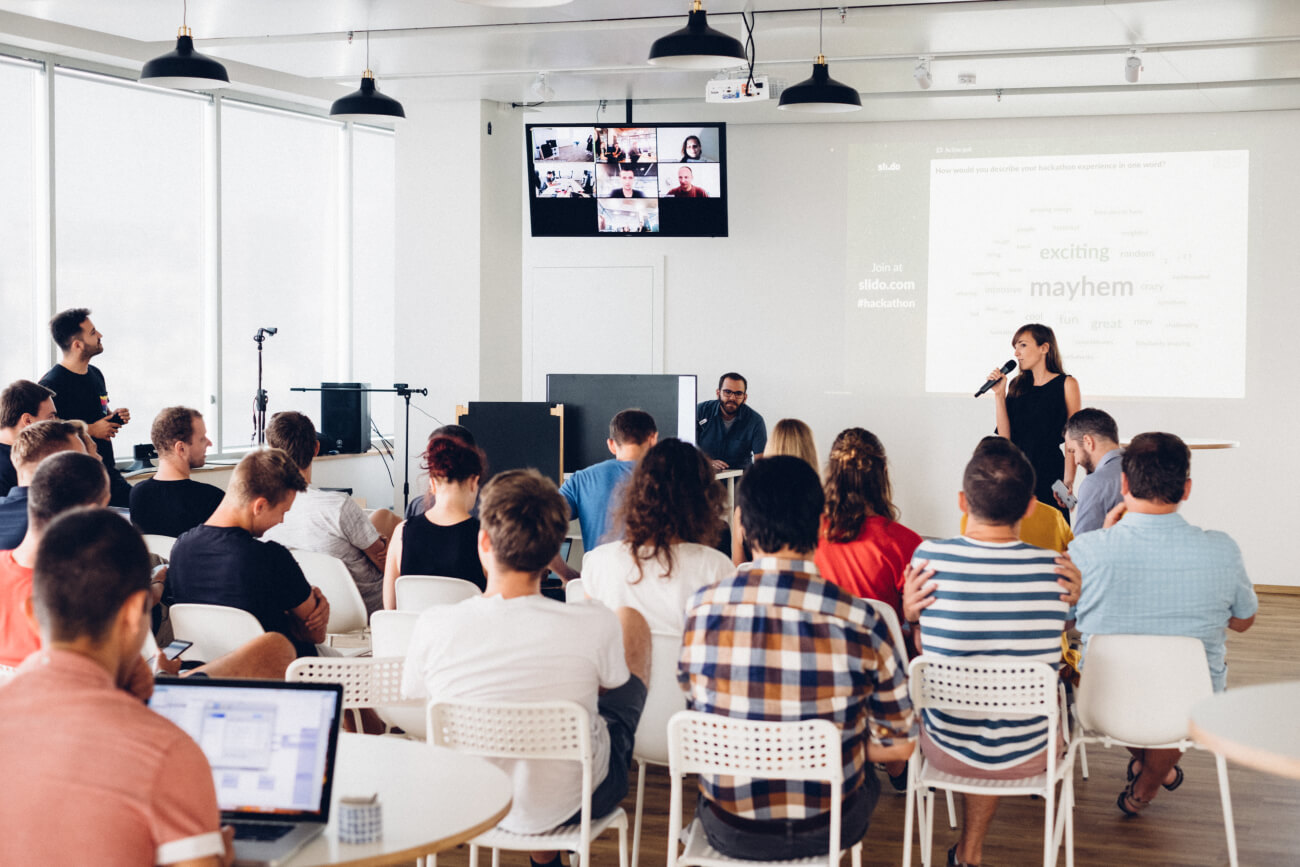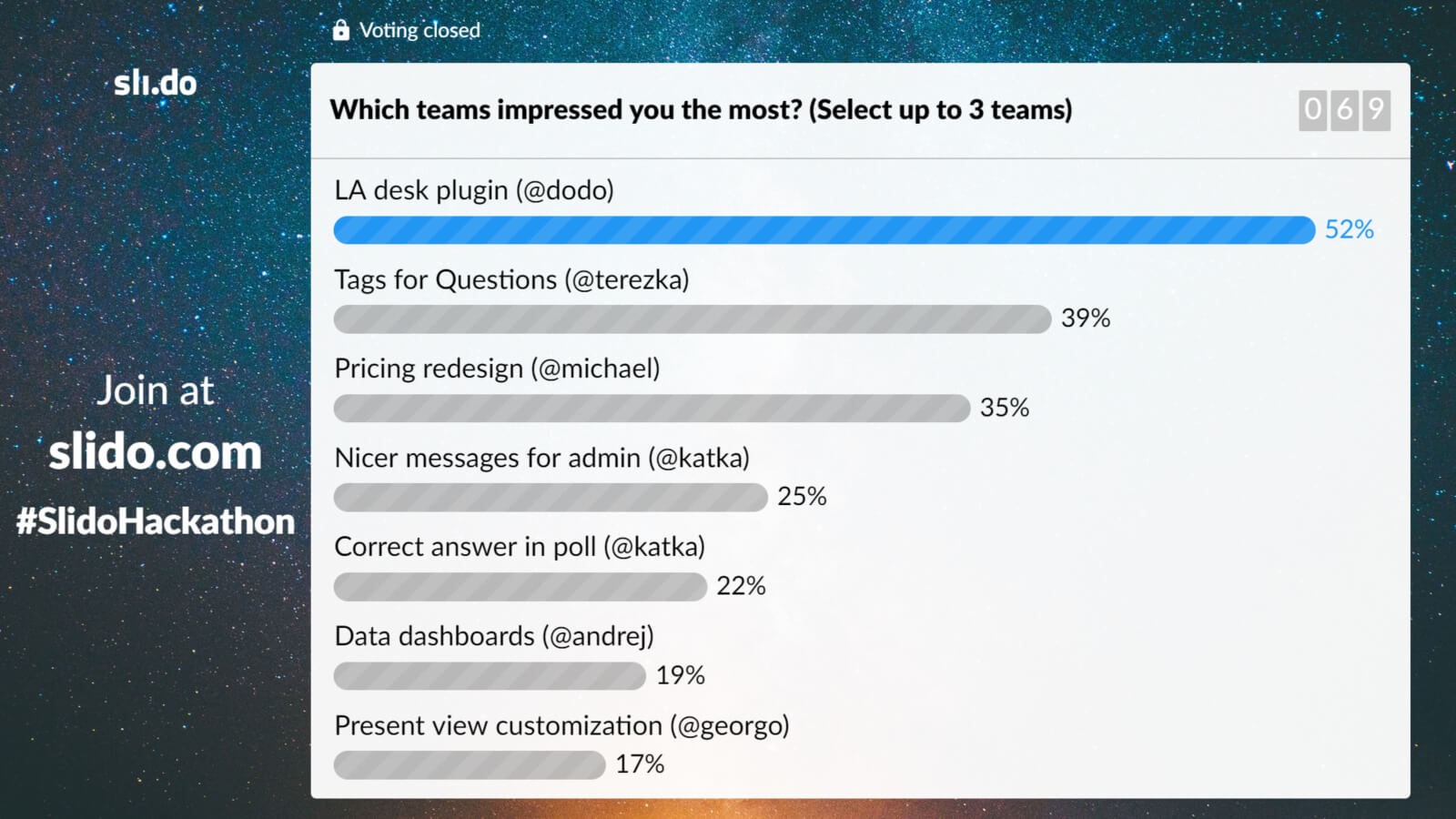When we hosted our very first internal hackathon, it was the ultimate team-bonding experience for the whole company. To show you how it looked in practice and how Slido helped us organize it more efficiently, here are a few tips for hosting a successful and interactive company hackathon.
1. Gather all the ideas beforehand
At most hackathons, people start collecting project ideas only when the event gets underway. Why not give people more time to think before they propose an idea? We experimented with this approach and it worked great.
One week leading up to our hackathon day, we created a simple Google spreadsheet where our colleagues could sign up and share their ideas. They were asked to provide a brief description and state whom they would need to realize their project (e.g., a designer, developer, or customer success advocate).
The document was shared with the whole company. This way, the other team members could review all the ideas and start thinking about which team they’d like to join even before the pitches took place.
Tip: If you collate more ideas than you are able to handle during your company hackathon, ask your team to vote for the ones they want to see realized. This will ensure that only the most popular ideas make it to the final selection.
2. Run a pitching round
While we were collecting project ideas, people were starting to get more and more excited about the hackathon. To keep the spirit high, we wanted to make the pitches as dynamic and efficient as possible.

Everyone had two minutes to present their idea and specify whom they’d need on their team. Then we hosted a 30-min “mix and mingle” round fueled by drinks and pizza, in which our colleagues were expected to form teams. After that, 40 hours of sweat and fun could begin.
But just before people went team hunting or rushed to secure their slice of pizza, we wanted to do a pulse check on the presented ideas and see how they resonated with our colleagues. To gauge their initial impressions, we ran a simple multiple-choice poll: Which 3 ideas should we work on during the hackathon?
3. Let people appoint the winning teams by live voting
40 hours later, we met in the same room for the final presentations and voting on the hackathon projects. We knew that stirring a bit of competition is a massive fire starter. Like most company hackathons, we also wanted our colleagues to appoint the winners.
But before we got to that, we first wanted to know how our team felt during the hustling hours. To scan the mood in the room, we ran a simple word cloud poll: How would you describe your hackathon experience in one word?

This little icebreaker exercise revealed that it was both fun and exhausting and allowed our team to compare their impressions with others.
Then we continued with a 7-min-per-presentation session of the hackathon projects.
After all the teams took turns on stage, we finally got to the most thrilling part. We activated a live poll and asked everyone to vote for the three teams that impressed them the most.

Once the votes were in, we revealed the results on screen and announced the winners. Our CEO Peter came on stage to congratulate them personally and wrap up the hackathon, expressing his thanks to everyone involved.
Tip: If you have a bigger team and the time allows it, you can reward more ideas by asking people to vote in different categories:
- the coolest idea
- the idea with the biggest impact
- the team with the most impressive effort, etc.
4. Get the team’s feedback on the hackathon
Finishing on a high note didn’t mean our job was done. As with almost every session we host at Slido, we like to hear people’s feedback to see what they liked and what can be done better next time.
So before we called it the most fabulous day, we activated a short feedback survey on Slido with the following questions:
- How would you rate this hackathon? (rating poll)
- How often should we do hackathons? (multiple choice poll: Once a year, Twice a year, Once a quarter, More than once a quarter, Never again)
- Have you learned something during the hackathon? (open text poll)
- Comments and suggestions for improvements (open text poll)

The survey was open for a couple of days so that people could send in their feedback even at a later date.
Seeing so many positive words flying in, we didn’t want to keep them to ourselves. Later, at our company offsite, we shared these encouraging comments with our team. It reminded them of the impressive team spirit they had exhibited and boosted their motivation for the upcoming season.
To sum it up, Slido helped us facilitate the company hackathon all the way through – from knowing people’s impressions to voting for the winning teams to gaining feedback on the whole event. If you want to try it out yourself, create your own hackathon event on Slido.




